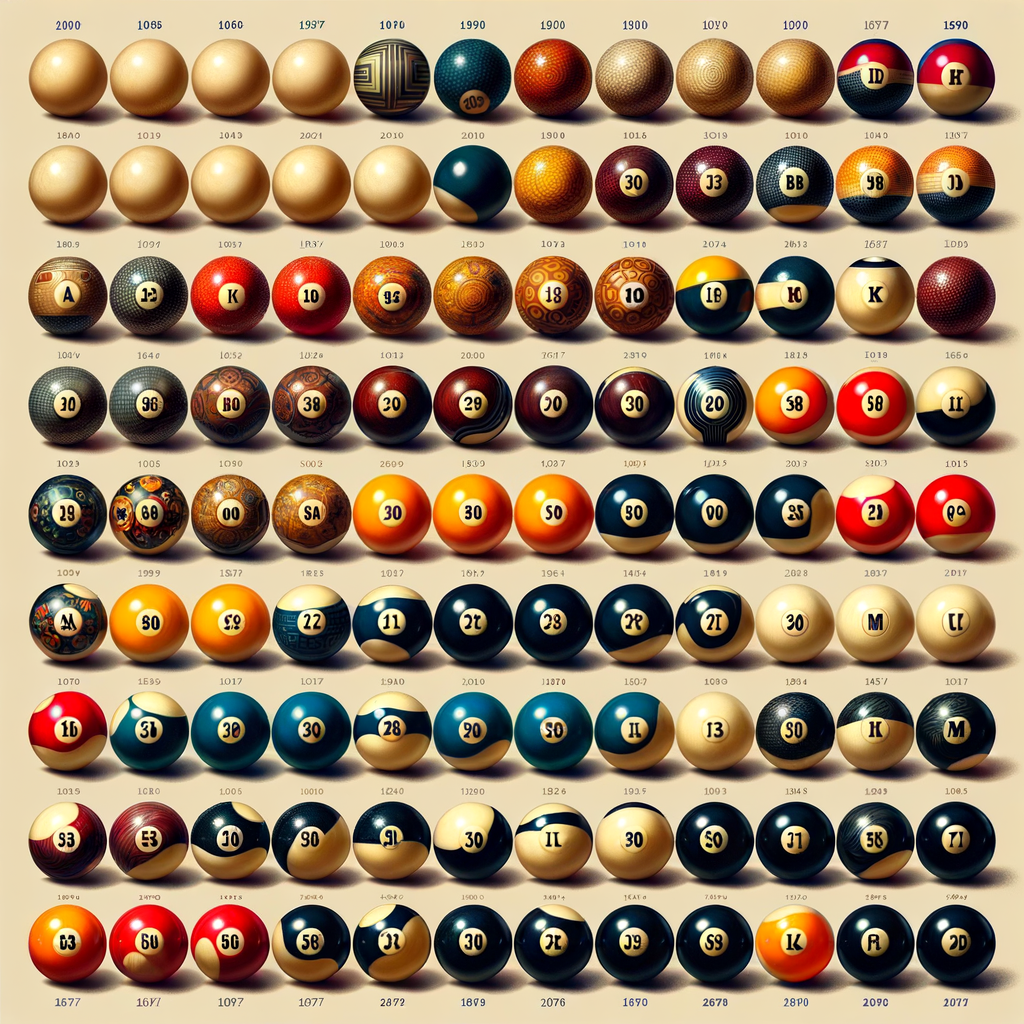
Introduction to the History of Billiard Balls
Billiard balls have a rich and fascinating history that spans centuries. They have evolved from simple wooden spheres to the colorful, high-performance balls we see on pool tables today. This journey has been marked by innovation, creativity, and a constant quest for improvement. Let’s dive into the captivating world of billiard balls and their evolution.
-
- Overview of the Billiard Balls History
The history of billiard balls dates back to the 15th century when they were made of wood and clay. In the 19th century, ivory was the material of choice, but it was expensive and led to the near-extinction of elephants. This prompted the search for alternative materials, leading to the invention of celluloid, the first synthetic plastic, in the 20th century. Today, billiard balls are made from phenolic resin, a material that offers superior durability and performance.
-
- The Importance of Understanding the Evolution of Billiard Balls
Understanding the evolution of billiard balls is crucial for several reasons. Firstly, it provides insights into the technological advancements and societal changes that have shaped the game of billiards. Secondly, it helps us appreciate the craftsmanship and innovation that go into making these seemingly simple objects. Lastly, it underscores the importance of sustainable practices in the manufacturing industry, as evidenced by the shift from ivory to synthetic materials.
As we journey through the history of billiard balls, we will uncover fascinating stories, interesting facts, and key milestones that have defined this game. So, let’s get started and explore the world of billiard balls!
The Early Days: Pre-1900s Billiard Balls
Let’s take a step back in time and explore the early days of billiard balls, before the 1900s. We will delve into the materials used and the changes in design and functionality that occurred during this period.
- Materials used in the early days
In the earliest days of billiards, the balls were primarily made from wood and clay. However, these materials were not durable and often chipped or broke during play. As the game gained popularity, manufacturers began to experiment with other materials.
By the mid-1800s, ivory became the material of choice for billiard balls. Ivory, derived from the tusks of elephants, was prized for its smooth texture and durability. However, the use of ivory posed significant ethical and environmental concerns, leading to a search for alternative materials.
- Changes in design and functionality
As the materials used to make billiard balls evolved, so too did their design and functionality. Initially, billiard balls were quite large and heavy, making the game more about brute strength than skill. However, as the game evolved, the balls became smaller and lighter, allowing for more precise shots and strategic play.
One significant change in the design of billiard balls was the introduction of numbers and colors. In the early days, all balls were white or off-white. The introduction of numbers and colors not only made the game more visually appealing but also allowed for a wider variety of games to be played on the same table.
In conclusion, the early days of billiard balls were a time of experimentation and innovation. The changes in materials and design laid the foundation for the game we know and love today.
The 1900s: A Century of Billiard Balls Development
The 1900s was a pivotal century for the development of billiard balls. This period witnessed significant changes in the materials used and the manufacturing processes employed. Let’s delve into the early 1900s to understand these transformations better.
Early 1900s Billiard Balls
In the early 1900s, the billiard industry underwent a revolution. The two main areas of development were the introduction of new materials and improvements in manufacturing processes.
-
- Introduction of new materials
At the turn of the century, billiard balls were primarily made of ivory. However, the overuse of ivory led to a decline in elephant populations. This sparked a search for alternative materials. In 1907, Leo Baekeland invented a plastic material called Bakelite. This material was durable, could be molded into round shapes, and was much cheaper than ivory. Bakelite soon became the material of choice for billiard balls, marking a significant shift in the industry.
-
- Improvements in manufacturing processes
Alongside the introduction of new materials, the early 1900s also saw improvements in the manufacturing processes of billiard balls. The use of Bakelite allowed for more efficient production methods. Manufacturers could now produce billiard balls in large quantities, reducing the cost and making the game more accessible to the masses. This period also saw the introduction of precision machinery, which ensured that each ball was perfectly round and of the same size, enhancing the quality of play.
In summary, the early 1900s marked a significant period in the history of billiard balls. The introduction of Bakelite and improvements in manufacturing processes revolutionized the industry, making the game more affordable and enjoyable for many.
Mid-1900s Billiard Balls Changes
The mid-1900s brought significant changes to the world of billiards. Two major factors that influenced these changes were the impact of World War II and technological advancements. Let’s delve into these factors and understand their effect on billiard balls.
- Impact of World War II on the billiard industry
World War II had a profound impact on many industries, including billiards. During this period, resources were scarce, and many factories that produced billiard balls were repurposed for the war effort. This led to a decline in the production of billiard balls.
However, the end of the war brought a resurgence in the popularity of billiards. Soldiers returning from the war sought leisure activities, and billiards was a popular choice. This increased demand for billiard balls and spurred the industry to innovate and improve their products.
- Technological advancements and their effect on billiard balls
As technology advanced, so did the manufacturing processes of billiard balls. New materials were introduced, such as plastic, which was more durable and cheaper to produce than the traditional ivory. This made billiard balls more accessible to the general public, increasing the popularity of the game.
Technological advancements also led to improvements in the precision and consistency of billiard balls. Machines were now able to produce balls that were perfectly round and of uniform size. This improved the quality of the game and made it more enjoyable for players.
In conclusion, the mid-1900s was a period of significant change for the billiard industry. The impact of World War II and technological advancements led to improvements in the quality and accessibility of billiard balls, contributing to the popularity of the game we know and love today.
Late 1900s Billiard Balls Progression
As we delve into the final phase of the 1900s, we’ll explore how billiard balls underwent significant modernization and the establishment of current standards and regulations.
- Modernization of Billiard Balls
During the late 1900s, the billiard industry experienced a wave of modernization. The manufacturing process of billiard balls was revolutionized with the advent of high-tech machinery and advanced materials. This era marked a shift from the traditional ivory balls to balls made from phenolic resin, a material that proved to be more durable and consistent in performance.
Phenolic resin balls were not only resistant to chipping and cracking, but they also maintained their shape and color for a longer period. This meant that players could enjoy a more consistent game, without having to worry about the balls wearing out quickly. The modernization of billiard balls greatly enhanced the quality of the game and brought about a new level of professionalism in the sport.
- Current Standards and Regulations
With the modernization of billiard balls, it became necessary to establish standards and regulations to ensure consistency and fairness in the game. The Billiard Congress of America (BCA) stepped in to set these standards. According to the BCA, a standard billiard ball should have a diameter of 2.25 inches and weigh approximately 5.5 to 6 ounces.
These regulations have been widely accepted and are now followed by manufacturers worldwide. They ensure that all billiard balls are produced to the same specifications, providing a uniform playing experience for all players, regardless of where they are in the world.
In conclusion, the late 1900s was a pivotal period in the history of billiard balls. The modernization of the balls and the establishment of standards and regulations have played a crucial role in shaping the game as we know it today.
Case Study: The Transformation of Pool Balls in the 1900s
As we delve deeper into the history of billiard balls, we come across a fascinating period of transformation. The 1900s brought about significant changes in the manufacturing and design of pool balls, which we will explore in this case study.
-
- Case Study Introduction
The 1900s was a time of innovation and change in many industries, including the world of billiards. The pool balls, which were once made of ivory, began to be replaced by synthetic materials due to concerns about the sustainability of ivory and the need for more durable and consistent playing equipment. This shift not only impacted the game but also had broader implications for the environment and the economy.
-
- Key Takeaways from the Case Study
There are several key insights we can draw from this transformation:
-
- Innovation Driven by Necessity: The shift from ivory to synthetic materials was driven by the need for a more sustainable and reliable material. This is a classic example of how necessity can drive innovation.
- Impact on the Game: The introduction of synthetic balls improved the consistency and predictability of the game, making it more enjoyable for players and spectators alike.
- Economic and Environmental Implications: The move away from ivory helped to protect elephant populations and created new opportunities in the synthetic materials industry.
In conclusion, the transformation of pool balls in the 1900s was a pivotal moment in the history of billiards. It not only changed the game but also had far-reaching effects on the economy and the environment. As we look back on this period, we can see how innovation and change can have a profound impact on our world.
Conclusion: Reflecting on the Evolution of Pool Balls in the 1900s
In this final section, we will summarize the key points about the evolution of pool balls during the 1900s and discuss what these changes might mean for the future of billiard balls.
-
- Summary of the 1900s pool balls evolution
The 1900s marked a significant period in the history of pool balls. At the start of the century, pool balls were primarily made from ivory, a material that was both expensive and environmentally damaging. However, as the century progressed, manufacturers began experimenting with new materials like celluloid and Bakelite. These materials were not only more affordable but also more durable and consistent in their performance. By the end of the century, pool balls had evolved from simple ivory spheres to complex, multi-layered objects made from synthetic materials.
-
- Implications for the future of billiard balls
The evolution of pool balls in the 1900s has set the stage for further advancements in the future. With the advent of new materials and manufacturing techniques, we can expect pool balls to become even more precise and durable. Moreover, the trend towards sustainability and environmental consciousness is likely to influence the materials used in pool ball production. In the future, we might see pool balls made from recycled or bio-based materials, which would reduce the environmental impact of the sport.
In conclusion, the 1900s were a pivotal century for the evolution of pool balls. The changes that took place during this period have not only improved the game of pool but also paved the way for future advancements. As we look to the future, we can expect the evolution of pool balls to continue, driven by technological advancements and a growing emphasis on sustainability.














